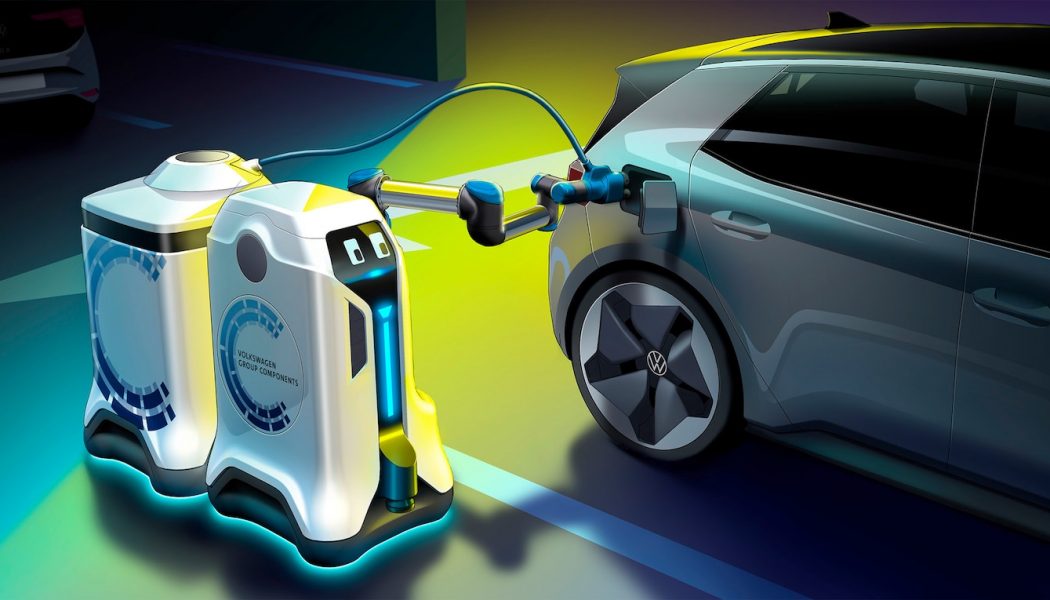In the tradition of Tesla’s annual Battery Day, Volkswagen just held its first Power Day. The globally broadcast virtual event laid out the company’s vision for the future of battery chemistry, pack design, manufacture, and recycling, as well as for building out a charging infrastructure, the discussion of which was capped off with this vision and mission statement: “With the right energy management and intelligent storage systems, one day charging will be for free.” Here are the highlights.
Volksbattery—An Almost 50 Percent Cost Reduction!
To deliver e-mobility the masses can afford, costs must come down. The VW Group reckons it can drop battery costs to around $100/kWh for its entry-level offerings. Here’s where that roughly 50 percent reduction in cost will come from when it hits the market in 2025:
20 Percent—Cell Chemistry (Anode and Cathode): By replacing pricy and increasingly difficult to source nickel, manganese, and cobalt cathodes with cheaper more abundant iron-phosphate materials, cost and supply-chain headaches are dramatically reduced. So is range—somewhat. Meanwhile, swapping graphite for synthetic graphite or silicon on the anode stands to boost range and/or recharge time.
15 Percent—Cell Design: Starting in 2023, the VW Group will begin transitioning to a new unified prismatic cell design across all applications, with an 80 percent adoption rate anticipated by 2030. The cells will feature different chemistries tailored to suit various use and cost targets, but they’ll lower costs for all and provide a more convenient form factor that facilitates the eventual transition to solid-state.
10 Percent—Production: VW is working to secure supply chains and bring battery manufacturing in-house, with an aim to have six gigafactories up and running by the end of the decade, each capable of producing 40 GWh of batteries per year. Skellefteå, Sweden will be the first of these to come online in 2023.
5 Percent—Battery System Concept: Today, cells are grouped in modules that are then integrated into a pack. VW sees an opportunity to reduce production and control circuitry costs by grouping cells directly into a pack.
Near Term: Three Traditional Battery Concepts
The lead-phosphate Volksbattery would never satisfy the volume customer in the market for a VW ID4 or Audi E-Tron, but the VW Group is working to lower costs for these customers, too. A nickel-manganese chemistry with greatly reduced nickel, along with some of the other savings noted above, promises to drop costs by 30 percent for volume products priced in the heart of the market. Together, the lead-phosphate and NiMn unified-cell batteries will account for 80 percent of group batteries. The third battery type accounting for the remaining 20 percent will serve special-use cases in vehicles such as the Porsche Taycan, Audi E-Tron GT RS, and future Bentley EVs. These may not conform to the unified cell design and could feature advanced chemistries employing traditional nickel-manganese-cobalt or innovative new materials that ultimately add cost.
Further Out: Solid State
As we’ve reported, VW is working with QuantumScape to develop solid-state batteries that have demonstrated an ability to charge from nearly depleted to 80 percent capacity in 12 minutes (10 is the internal target), while demonstrating 30 percent greater overall range—two keys to making long-distance travel by electric vehicle more viable.
Expanding Scope Along Value Chain
With 80 percent of a battery cell’s value currently locked in the mining, and chemical manufacture currently handled by the supply chain, the final 20 percent of value comes from the cell’s ultimate manufacture. VW is therefore exploring and entering partnerships to increase its stake upstream in the value chain.
Second Life
VW still envisions a second life for battery packs whose storage capacity has fallen below the 70 percent charge capacity most warranties cover. In such instances, these batteries could find a second life storing surplus wind, solar, or tidal energy—or energy from other green sources. The presentation noted that VW Group will dedicate some production capacity to assembling large-scale storage batteries, including processing second-life EV batteries.
Battery Recycling
When a battery pack is no longer useful or damaged in a crash, recycling is imperative. VW just opened its first industrial battery recycling center for this purpose in Salzgitter, Germany in January 2021. Car batteries received are first intensely discharged, then the pack is dismantled to the module or cell level. These parts are fed through a shredder and various separators, then the materials are subjected to a hydrometallurgy process that ultimately reclaims 95 percent of the battery recycled—essentially everything but the separator.
Producing cathodes from recycled materials promises to eliminate more than a ton of CO2 per vehicle from the manufacturing process. Costs also fall, directly benefitting the customer.
Bi-Directional DC Wallbox for Blackout/Brownout Power
Much of the second hour of VW’s Power Day presentation was devoted to charging infrastructure expansion efforts, especially in Europe and China. The group’s new DC Wallbox was also shown, after having been deployed in some prototype locations around Germany. This concept is like a Level 2.5 charger; it provides DC power like a Level 3 charger, but at a much lower power rate of 22 kW, which is slightly higher than most Level 2 chargers. Its big party trick is being bi-directional. This allows a vehicle to supply energy back to the home or power grid. VW notes that the 77-kWh battery in an ID4 could power a typical house for five days. (We’re unsure of the conversion from German household energy usage per day to Texas house usage, but that would have proven handy in February).
Other Charging Concepts
A precious robo-charger, complete with googly digital eyes, also crossed the stage a few times during the presentation. It’s envisioned as a parking-deck “Mobile Charging Robot” you summon and pay via a smart-phone app. A fleet of little battery-charger “trailers” stay plugged in until you summon a recharge via the app. Then a smart robot tow vehicle hooks up a charger pod, brings it to your car, connects, and leaves it charging, returning to await the next request (or to return to a charging pod). The charging rate of this prototype design has not been disclosed yet, but the plug shown includes DC connector poles.
Finally, a FLEXpole charging station was briefly shown. This 150-kW DC fast-charger can be powered by low-voltage/current electricity. It stores energy in large onboard battery packs (some of which can be sourced from out-of-spec EV batteries), then dispenses the power at 150 kW. These are being deployed in China now.










